VT Dendro Lab Notes
paper birch
Betulaceae
Betula papyrifera
Leaf: Alternate, simple, pinnately-veined, ovate in shape, 3 to 5 inches long, with irregularly doubly serrate margins, an acute tip and rounded base (occasionally heart-shaped), green above and paler below.
Flower: Species is monoecious; preformed male catkins near the end of the twig in groups of 2 to 5, 3/4 to 1 1/4 inches long; female are upright, 1 to 1 1/4 inches long, appear or elongate (males) in mid-spring.
Fruit: Cone like, cylindrical 1 to 1 1/2 inches long, deciduous at maturity, releasing elliptical 2-winged nutlets, mature in the autumn and disperse over the winter.
Twig: Slender, dull red-brown, numerous lighter lenticels, lacking wintergreen smell when cut; terminal bud absent, lateral buds are gummy, green and chestnut brown in color, spur shoots present on older growth.
Bark: Reddish brown with light lenticels on very young stems; later turning chalky to creamy white, peeling in horizontal papery strips; brown to black and may be furrowed at base; orange inner bark.
Form: A medium sized tree to 70 feet with a pyramidal or irregular crown, often with several trunks.
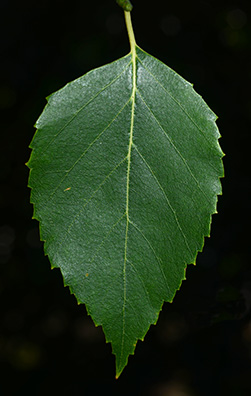


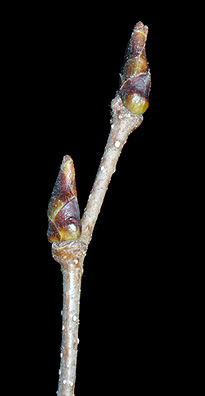
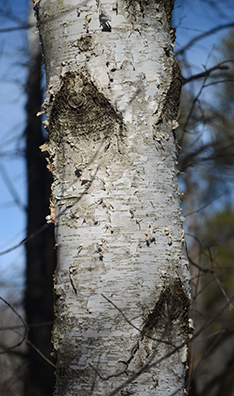
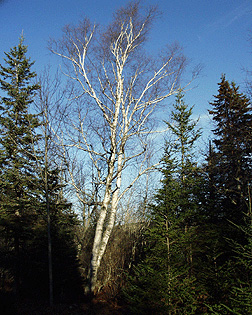

Notes:
VT Dendro Lab Notes
gray birch
Betulaceae
Betula populifolia
Leaf: Alternate, simple, pinnately-veined, triangular with a very elongated acuminate tip, 2 to 3 inches long, doubly serrate margin, green above and paler below.
Flower: Species is monoecious; preformed male catkins near the end of the twig, 3/4 inch long, usually single; female upright, 1/2 inch long; appear or elongate (males) in early spring.
Fruit: Cone like, cylindrical, 3/4 inch long, deciduous at maturity, releasing tiny 2-winged nutlets. Matures in autumn, disperses over winter.
Twig: Slender, orange-brown to gray in color with warty, raised lenticels that give the twig a rough feel; buds are slender, pointed, green and brown, terminal bud is lacking.
Bark: Reddish brown with numerous lighter lenticels on very young stems, later turning gray to white and very chalky; remains smooth and generally does not peel.
Form: Small tree rarely over 30 feet tall typically with multiple trunks and a limby bole. The crown is irregular in shape with somewhat drooping slender branches.


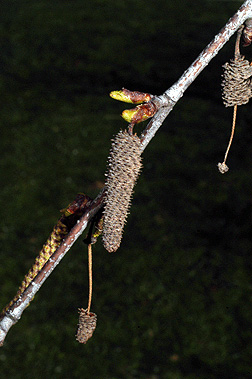




Notes:
VT Dendro Lab Notes
hornbeam
Betulaceae
Carpinus caroliniana
Leaf: Alternate, simple, elliptical to ovate, 3 to 5 inches long, pinnately veined, tip acuminate, doubly serrate margin; waxy, smooth green above, paler below.
Flower: Species is monoecious; males catkins yellow-green, 1 to 2 inches long, hanging; female catkins yellow-green and fuzzy appearing from new branch tips, 1/2 to 3/4 inch long, both appearing in mid to late spring.
Fruit: Small ribbed nutlet carried on a 3-lobed, slightly folded leafy bract that is 1 inch long (somewhat resembles a maple leaf), bracts are clustered on a long (4 to 6 inches) hanging stalk; ripen in late summer and fall, disperse through the winter.
Twig: Slender, somewhat zigzag, brown to gray in color; buds are brown, angled, with a tan silky edge to each scale (making the buds appear lined), approximately 1/4 inch or less in length.
Bark: Thin, smooth, gray to bluish gray regardless of age or size; trunk is fluted heavily, resulting in a muscular appearance.
Form: A small, nearly shrubby tree reaching up to 25 feet tall with a rounded crown and a twisted trunk.







Notes:
VT Dendro Lab Notes
northern catalpa
Bignoniaceae
Catalpa speciosa
Leaf: Whorled (or opposite, when whorled one of the three leaves is often smaller), cordate, 5 to 12 inches long, pinnately veined, entire margins, overall soft and flexible feeling, light green to green above and soft pubescence on the underside.
Flower: Species is monoecious; very showy, white (yellow and purple spots on insides), 5 fuzzy petals form an overall bell shape, 1 inch long; appear in open, branched, upright terminal cluster (8 to 12 inches long) in late spring.
Fruit: Long (10 to 18 inches) bean-like, hanging capsules, round in cross section, very stiff; each capsule contains numerous flattened seeds with 2-papery, fringed wings; the seeds mature in autumn, but the capsule may remain attached over winter.
Twig: Stout, green, and later reddish brown in color, numerous lighter lenticels; terminal bud is absent, lateral buds are small and covered with red-brown scales; leaf scars very unique elliptical or round sunken saucers, light in color.
Bark: Gray to reddish brown, separated into irregular shallow fissures and scaly ridges.
Form: A medium sized tree to 80 feet with spreading, crooked branches and an irregular crown. The bole may be straight but is generally crooked.







Notes:
VT Dendro Lab Notes
eastern redcedar
Cupressaceae
Juniperus virginiana
Leaf: Evergreen, very small, with two types of leaves (often on the same tree), scale-like leaves 1/16 inch long, dark green, with 4 sides held tightly to twig and longer (1/4 inch), dark blue-green needle-like leaves that are more common on young trees and fast growing shoots.
Flower: Species is dioecious, but occasionally monoecious; males are small, yellow-brown, occurring in large groups; females are light blue-green.
Fruit: Berry-like cones, light green in spring, turning dark blue and glaucous at maturity, about 1/4 inch in diameter, appearing in spring and maturing in the fall.
Twig: Green for several years, covered in scales, later turning brown.
Bark: Red-brown in color, exfoliating in long, fibrous strips, often ashy gray where exposed.
Form: A small tree with a dense ovoid or columnar crown reaching up to 60 feet tall.







Notes:
VT Dendro Lab Notes
common persimmon
Ebenaceae
Diospyros virginiana
Leaf: Alternate, simple, oblong to oval, 2 1/2 to 5 inches long, pinnately-veined, margin entire, lustrous green above and paler or whitened below.
Flower: Species is usually dioecious; both white to greenish-white and about 1/2 inch long; male flowers in 3's; female flowers solitary and urn-shaped, appear in late spring and early summer.
Fruit: A plum-like berry that is green before ripening, turning orange to black when ripe, 3/4 to 2 inches in diameter, leafy bracts on top of fruit. The fruit is very astringent and mouth numbing when green, sweet and edible when ripe after a hard freeze; matures in mid to late fall.
Twig: Slender, light brown to gray, maybe scabrous or pubescent; no true terminal bud and twig scar is often very prominent, buds triangular, appressed, dark red to black with 2 bud scales; leaf scar has one oval vascular bundle trace.
Bark: When young gray-brown with orange in fissures, later becoming much darker, breaking up into square scaly thick plates; reminiscent of charcoal briquettes (very unique).
Form: A small to medium sized tree to 60 feet with a round-topped crown of crooked branches. In forest stands the stem may be straight, tall, and slender.







Notes:
VT Dendro Lab Notes
bitternut hickory
Juglandaceae
Carya cordiformis
Leaf: Alternate, pinnately compound, 7 to 10 inches long, with 7 to 11 leaflets, leaflets are lanceolate and serrate, rachis is slender and pubescent, dark green above, paler below.
Flower: Species is monoecious; males are yellow-green, drooping catkins with 3 hanging from one stalk, 3 to 4 inches long; females are short, 4-angled, on a terminal spike, appearing in spring.
Fruit: Nearly globose but slightly flattened, 1 inch long, partially dehiscent from the middle to the sharp-pointed tip; husk is thin and 4-winged above the middle, often dusty-yellow looking; maturing in fall.
Twig: Moderately stout to slender (when compared to other hickories), leaf scars are 3-lobed; terminal bud is valvate, 4-angled and sulfur-yellow to brown in color.
Bark: Thin, tight and hard; initially smooth and silvery gray, much later gray with shallow furrows and interlacing ridges.
Form: A medium to large tree capable of reaching over 100 feet tall with an open, rounded top.







Notes:
VT Dendro Lab Notes
pignut hickory
Juglandaceae
Carya glabra
Leaf: Alternate, pinnately compound, 8 to 12 inches long, with 5 (sometimes 7) leaflets, leaflets are lanceolate and serrate, rachis slender and glabrous, green above and paler below.
Flower: Species is monoecious; males are yellow-green, drooping catkins, with three hanging from one stalk, 2 to 3 inches long; females are very short and found in clusters at the end of the branches, both appear in spring.
Fruit: Obovoid to pear-shaped, 1 to 2 inches long, with a thin husk that only partially splits upon maturation; nut is not ribbed, fairly round but flattened, seed is somewhat bitter; ripening in early fall.
Twig: Moderately stout to slender (when compared to the other hickories) and glabrous; leaf scars are 3-lobed to cordate - best described as a "monkey face"; terminal bud is small (1/4 inch), ovate and light brown in color.
Bark: Initially smooth, and light gray, soon developing scaly ridges; the bark on older trees has obvious close interlacing shaggy-topped ridges.
Form: A medium sized to large tree capable of reaching over 100 feet tall, with a rounded crown and a straight trunk.







Notes:
VT Dendro Lab Notes
shagbark hickory
Juglandaceae
Carya ovata
Leaf: Alternate, pinnately compound, 8 to 14 inches long with 5 (sometimes 7) leaflets, lateral leaflets are obovate to lanceolate, terminal leaflets are much larger than the laterals, margins serrate and ciliate, rachis stout and mostly glabrous; green above and paler below.
Flower: Species is monoecious; male flowers are yellow-green catkins, hanging in 3's, 2 to 3 inches long; females are very short, in clusters at the end of branches, both appear spring.
Fruit: Nearly round, 1 1/2 to 2 inches, with a very thick husk; nut is distinctly 4-ribbed, and the seed is sweet and delicious; maturing in fall.
Twig: Stout and usually tomentose, but may be somewhat pubescent near terminal bud, numerous lighter lenticels; leaf scars are raised, 3-lobed to semicircular - best described as a "monkey face"; terminal bud is large, brown, and pubescent, covered with 3 to 4 brown scales, more elongated than other hickories.
Bark: At first smooth and gray, later broken into long, wide plates attached at the middle, curving away from the trunk resulting in a coarsely shaggy appearance.
Form: A tall tree reaching over 120 feet tall with a straight trunk and an open round to oblong crown.







Notes:
VT Dendro Lab Notes
mockernut hickory
Juglandaceae
Carya tomentosa
Leaf: Alternate, pinnately compound, 9 to 14 inches long, with 7 to 9 serrate, lanceolate to obovate-lanceolate leaflets, rachis is stout and very pubescent, green above and paler below.
Flower: Species is monoecious; male flowers are yellow-green drooping catkins, with 3 hanging from one stalk, 3 to 4 inches long; female flowers are very small in clusters of 2 to 5 near the tip of the twig, both appear in spring.
Fruit: Obovoid to ellipsoidal in shape, 1 1/2 to 2 inches long, husk is thick (although less thick than C. ovata) and splits cleanly open, strongly 4-ribbed nut, with sweet and edible meat, matures in early fall.
Twig: Stout and pubescent, the 3-lobed leaf scars are best described as a "monkey face"; terminal bud is very large, broadly ovate (Hersey kiss-shaped), darker outer scales are deciduous in the fall, revealing a silky, nearly white bud.
Bark: Initially gray and smooth, later developing interlaced round-topped, light gray ridges and shallow, darker, furrows, never shaggy or exfoliating.
Form: A medium sized to large tree capable of reaching over 100 feet tall with a straight stem and a rounded crown.







Notes:
VT Dendro Lab Notes
European larch
Pinaceae
Larix decidua
Leaf: Deciduous, appearing singly on new growth and in whorls on older growth, 1 inch long, light green in color.
Flower: Species is monoecious; males light yellow, small and round; females yellow to red, with long, curved scales.
Fruit: Cones are 1 to 1 1/2 inches long, ovoid, composed of many scales that are longer than the bracts, borne upright on the twig, maturing fall to early winter.
Twig: Straw-colored, bearing rounded buds. Spur shoots present on older growth, buds dark brown.
Bark: On young trees the bark is scaly and gray, later becoming furrowed with a reddish brown inner bark.
Form: Well formed, with a straight stem, pyramidal crown, and drooping lateral branches.







Notes:
VT Dendro Lab Notes
hawthorn
Rosaceae
Crataegus spp.
Leaf: Highly variable, but generally alternate, simple, 2 to 4 inches long, serrate and lobed (may be unlobed), subtending long thorns, dark green above and paler below.
Flower: Perfect, usually small white flowers, with 5 petals produced in clusters near the end of the twig, appearing in mid to late spring.
Fruit: Small pomes, generally 1/4 inch in diameter, yellow to red when mature; maturing in the early fall.
Twig: Slender, gray in color, with true terminal buds that are usually dark, shiny red and round. Most species have obvious, stiff, 1 inch long thorns; leaf scars contain 3 bundle scars.
Bark: Smooth and gray-brown when young, later turning darker and scaly.
Form: Generally very dense shrubs or small trees up to 25 feet.







Notes:
VT Dendro Lab Notes
American basswood
Tiliaceae
Tilia americana
Leaf: Alternate, simple, ovate to cordate, 5 to 6 inches long, with serrate margins, pinnately veined, base is unequally cordate, green above and paler below.
Flower: Species is monoecious; pale yellow, borne below a long, gracefully curving leafy wing in a many branched cluster, several inches long, appearing in early to mid-summer.
Fruit: A round nutlet (1/4 inch) that is covered with gray-brown hair; occur in a hanging cluster with a curving, leafy bract acting as wing on top of the cluster, ripening in the fall.
Twig: Moderately stout, zigzag, green (summer) or red (winter); terminal bud is false, each very plump with one side bulging out disproportionately. Buds are edible but very mucilaginous.
Bark: At first smooth and gray-green, later turning gray-brown and becoming ridged with long, shallow furrows and flat topped ridges. The bark is very fibrous.
Form: A medium sized tree to 80 feet. Older trees very often sprout from the base when cut. Stumps sprout prolifically, often resulting in clumps of several trees.







Notes:
VT Dendro Lab Notes
littleleaf linden
Tiliaceae
Tilia cordata
Leaf: Alternate, simple, asymmetrical cordate, 1.5 to 3 inches long, with sharp, finely serrate margins, pinnately veined, asymetrical base, green above, paler below with light brown pubescence in vein axils.
Flower: Species is monoecious; pale yellow, borne below a long, gracefully curving leafy wing in a many (5 to 7) branched cluster, emerging in all directions from twig (not all hanging downward) several inches long, appearing in early to mid-summer.
Fruit: A round nutlet (1/5 inch) that is covered with gray-brown hair; generally smooth but may be slightly ribbed, occur in a hanging cluster of 2 or 3 with a curving, leafy bract acting as a wing on top of the cluster, ripening in the fall.
Twig: Slender, zigzag, green-brown or red-tinged (particularly in the winter); terminal bud is false (1/8 inch long), buds are plump with one side bulging conspicuously, green to red in winter, edible and when eaten they are mucilaginous.
Bark: Gray or brown, ridged with shallow furrows and flat ridges; young stems are brown with shallow splits and furrows. Inner bark is quite fibrous.
Form: A small to medium tree to 60 feet with a dense, round crown. In the U.S. it is typically only seen when open grown where initially it is pyramidal but generally becomes as wide as it is tall. Numerous burls and sprouts often found around the base of the tree.







Notes:

































































































